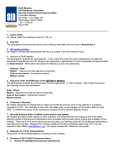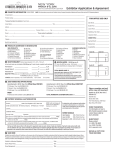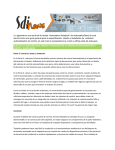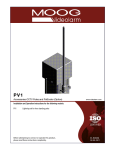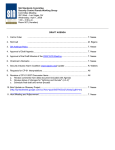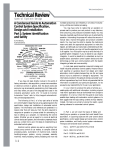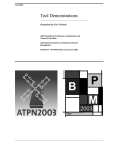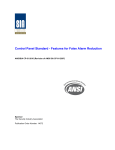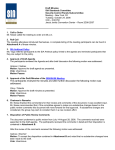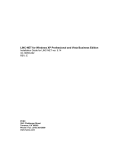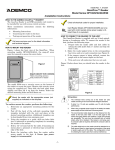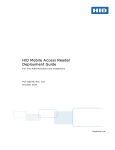Download Minutes_2008-10-29 - Security Industry Association
Transcript
Draft Minutes SIA Standards Committee Security Control Panels Working Group Committee Meeting ISC East – New York, NY Wednesday, October 29, 2008 2:00 – 3:30 p.m. Room 1E-08 (Javits) 1. Call to Order Mr. Nesse called the meeting to order at 2:05 p.m. 2. Roll Call The participants introduced themselves and a listing of attendees can be found in Attachment A. 3. SIA Antitrust Policy Mr. Nesse reminded the participants that they are subject to the SIA Antitrust Policy. 4. Approval of Draft Agenda The participants reviewed the draft agenda. It was noted that the following late documents were added to the agenda: • 9.a.iii. Contribution on Unvacated Premises (Worst/Shelton) • 9.a.iv. Contribution on Section 4.6. Installation (Nesse) • 9.c. UL Statement on Services for CP-01 and Summary of Requirements These are appended to these minutes as Attachment B, C, and D respectively. After further discussion the following motion was addressed: Hinkson / Worst Motion: “Approve the draft agenda as amended.” Vote on the motion: Unanimous consent. Motion carries. 5. Approval of the Draft Minutes of the 2008/04/02 Meeting The participants reviewed the draft minutes from the April 2, 2008 meeting. After further discussion, the following motion was addressed: Harris / Worst Motion: “Approve the draft minutes as presented.” Vote on the motion: Unanimous consent. Motion carries. 6. Chairman’s Remarks Mr. Nesse noted that the group is currently dealing with two initiatives: Revision of CP-01 and work on the preparation of SIA glossary. With regard to the CP-01 Revision effort the target completion is April 2009. There are at least three contributions the group will be resolving at this meeting and to complete the effort the following needs to be completed: − − − − mid December: circulate a delta document for committee input and comment mid January: teleconference to disposition any pending committee comments on CP01 mid February: prepare and circulate final draft for committee review ISC West: disposition any comments, start ANSI approval process which would be the initiation of a formal public review. Regarding the SIA Glossary project the following are questions that will need to be resolved for the effort: − There has been substantial discussion about the broader glossary initiative. Should our subcommittee proceed with our narrower effort on control panels, or wait for the broader effort to take form? − Also a question about whether the glossary would be normative or informative. • project proposal implies normative • but informative is easier to produce • Should we proceed on the basis of a normative or an informative glossary? − SIA Glossary Project – Use and Maintenance Scenario; one possible use and maintenance scenario if the glossary is normative • three possibilities for new standards o reference definitions in the then-current version of the glossary (and not include the definitions again in the new standard) o draw definitions from the glossary and duplicate them in the new standard o define new glossary terms − periodically, the glossary will be revised to pull in new terms from new standards − glossary may also update definitions of terms, but this does not change standards that reference terms from the glossary, as those standards would refer to a specific version (date) of the glossary − Glossary Timeline: target submission for public comment is April 2009 − At this meeting: • approve or reject all terms proposed for inclusion (just whether they are included, not definitions themselves) • accept as many existing definitions as possible • assign included but undefined terms to committee members to prepare proposed definitions − By mid December • teleconference to accept proposed definitions • assign remaining terms for definition or refinement − By mid February teleconference to accept proposed definitions − By end February prepare and circulate final draft to committee for comment − ISC West disposition any comments, start ANSI approval process 7. Security Industry Alarm Coalition (www.siacinc.org) Update Mr. Walters provided the participants with the latest CP-01 Control Panel Compliance List – Summary that the SIAC maintains. A copy of it may also be viewed at their website at: http://www.siacinc.org/dealer_standards.asp. The list also points to the UL database that is viewable online. At the same webpage there is also a SIA CP-01 City Specified List dates 10/18/2008. He also noted that there are Enhanced Call Verification briefing papers also posted to the website at: http://www.siacinc.org/Monthly%20Briefings.asp. A draft of An Executive Overview of Dispatch Reduction and Verified Response was also handed out in hard copy. Mr. Nesse thanked Mr. Walters for providing the update. 8. Requests for CP-01 Interpretations There were no requests for interpretations discussed at this meeting. 9. Revision of CP-01-2007 Discussion Items a. Review of Highlighted Issues (see attachments) A number of the contributions below related to the Highlighted issues. The participants moved on to the next agenda item. i. Contribution on Lightning and Thunder Mr. Clark presented his contribution as a result of the previous meeting at ISC West. Many of the participants noted that this should be optional as the there might not be a sensor. Mr. Worst spoke in favor of defining the requirements as a smoke detector loop is currently defined. Mr. Chavez queried as to if the requirement is options will it have a negative effort on the panel? He also noted that UL96 and UL96A are standards for lightning; however, they are not intended to be connected to a panel. Mr. Clark was directed to refer back to another revision that takes into account the following: 1. Optional Feature 2. Verify if failure of sensor would allow panel to detect alarms 3. Bring it back to the committee for further review. UL noted that there is no differentiation between residential or commercial on the issue of suppression. The only issue relates to fire alarms and there no suppression of fire alarms. The participants also requested Mr. Clark to investigate the UL position on suppression as well. 4. UL position on suppression. Mr. Nesse thanked Mr. Clark for his continuing efforts. ii. Contribution on Zone Type Definition The participants reviewed Mr. Hinkson’s contribution on a Zone Type definition and agreed to add this to the draft revision effort. iii. Late Contribution on Auto Stay Feature for Section 4.2.2.5 Un vacated Premises The participants reviewed the late contribution submitted by Mr. Worst and Mr. Shelton (see Attachment B). It was noted that the revision list incorrectly points to Section 4.1 and it should be 4.2.2.5. There was discussion on whether or not it is armed within the premises and agreed that this was applicable to only interior zone types. The following were revisions discussed during the meeting: “4.1 Partitioned Systems Partitioned systems shall provide the requirements of Clause 4.2 User Caused False Alarms, 4.3 Sensor Caused False Alarms, and 4.6 Installation and Test for each partition. Each partition needs to be able to support the requirements in Clause 4. In testing, it will be acceptable to test 2 partitions as indicative of the product's ability to meet the requirements in all partitions. 4.1.1 Independent Partitions – Option If the system user operates a partitioned system, with each partition being operated independent of each other, there shall be a system option indicating this manner of behavior. When enabled each partition shall behave as if there were no other partitions, incorporating all of the features of this standard. If not enabled, then when a partition is armed and/or disarmed all partitions take on the state of said partition. 4.2.2.5 Unvacated Premises An option shall be provided which allows the security system to Arm in the Stay Arm mode if the Exit Time expires and no exit has been made. The default setting for this option shall be that it is enabled. This option is not required when the system is only Armed from outside of the protected area with a remote control device or remote Arming Station, or when areas of the system do not form a perimeter and interior arrangement or have "Stay" or "Away" Arming states. This option is required when the system is armed by a user action from inside the protected premises, or when areas of the system do not form a perimeter and interior arrangement or have "Stay" or "Away" Arming states. “ Mr. Hinkson agreed to make another attempt to provide a contribution for the next teleconference. Mr. Nesse thanked Mr. Hinkson for taking the action item and thanked Mr. Worst and Mr. Shelton for the contribution at this meeting. iv. Late Contribution on 4.6.1 Product Documentation The participants reviewed the late contribution from Mr. Nesse on 4.6.1 (see Attachment C). Mr. Nesse also noted additional changes to the contribution: Revised text: “Consult with your installer to determine if your system is configured with a communicator delay. A communicator delay will prevent a report to the central station if the control panel is disarmed within 3045 seconds after an intrusion alarm is triggered. Note that fire-type alarms are normally reported without a delay.” Original text: “There is a communicator delay of 30 seconds in this control panel. It can be removed, or it can be increased up to 45 seconds, at the option of the end user by consulting with the installer.” The participants agreed to the revised text and also requested the contribution be further refined in the area of the table to incorporate further clarification that the features are required and if there are parts of the feature that may be programmable; this table provided further requirements on the documentation. Mr. Nesse will take the action item to provide that further clarification. b. Ratification of Disposition of Items Those undertaking action items will provide their input back for the next teleconference. c. Discussion on Draft UL Bulletin Information The participants reviewed a draft bulletin (Attachment C) and a Summary of Requirements document from UL discussing the current revisions (Attachment D). Any comments on Attachment C should be directed to Ms. Rigano. Staff will also run a copy in the SIA News. Regarding the draft document on the summary of requirements, participants wanted further clarification on the sunset dates on classifications. 10. Proposal for Security Industry Glossary Development Project a. Update on October 16 Teleconference b. Review of Terms (http://spreadsheets.google.com/ccc?key=pqqV5kSTN3DzIj7LfdsdpCg&hl=en) There was insufficient time to address this agenda item at the meeting and it will be discussed on the next teleconference. 11. Next Meeting and Adjournment The next meeting will be a teleconference on Thursday December 11, 2008 from 3-5 p.m. Eastern to work on the glossary project. The meeting was adjourned (Wachtel / Dischert) at 3:35 p.m. Attachment A – Attendee Listing for the October 29, 2008 - Security Control Panels Working Group 2GigSecurity ................................................................................................ Scott Simon* ADT.............................................................................................................. Bernie Worst ADT.............................................................................................................. Larry Dischert* Argyle Security & SecTecGlobal, Inc........................................................... Alan Wachtel Brinks Home Security .................................................................................. Dave Simon DMP ............................................................................................................ Terry Shelton* DSC ............................................................................................................. Kevin Harris DSC ............................................................................................................. Dan Nita* Honeywell .................................................................................................... Rich Hinkson Phoenix, Police Department ........................................................................ Becky Buccanon* SIAC ............................................................................................................ Ron Walters UL ................................................................................................................ Al Gengler UL ................................................................................................................ Bryon Monte UL ................................................................................................................ Ron Fedorowicz UL ................................................................................................................ Sergio Blanch UL ................................................................................................................ Lou Chavez Security Industry Association....................................................................... Monica Rigano *Denotes participated via teleconference. ATTACHMENT B – Agenda 9aTerry Shelton and I have collaborated to provide the requested modification to clarify the auto stay feature (erroneously listed as 4.1 in your comments column), section 4.2.2.5 Unvacated Premises. See below. Bernie ------------------------------------------------------------------------------------------------- Bernard I. Worst Director of Engineering ADT Security Services, Inc. 695 US Highway 46; Suite 200 Fairfield, NJ 07004-1561 Tel: 973-439-6532 Fax: 509-357-5981 ================================================================================ 4.1 Partitioned Systems Partitioned systems shall provide the requirements of Clause 4.2 User Caused False Alarms, 4.3 Sensor Caused False Alarms, and 4.6 Installation and Test for each partition. Each partition needs to be able to support the requirements in Clause 4. In testing, it will be acceptable to test 2 partitions as indicative of the product's ability to meet the requirements in all partitions. 4.1.1 Independent Partitions – Option If the system user operates a partitioned system, with each partition being operated independent of each other, there shall be a system option indicating this manner of behavior. When enabled each partition shall behave as if there were no other partitions, incorporating all of the features of this standard. If not enabled, then when a partition is armed and/or disarmed all partitions take on the state of said partition. 4.2.2.5 Unvacated Premises An option shall be provided which allows the security system to Arm in the Stay Arm mode if the Exit Time expires and no exit has been made. The default setting for this option shall be that it is enabled. This option is not required when the system is Armed from outside of the protected area with a remote control device or remote Arming Station, or when areas of the system do not form a perimeter and interior arrangement or have "Stay" or "Away" Arming states. ATTACHMENT C – Proposed Text for Section 4.6.1 SIA Control Panels Subcommittee Contribution Proposed Text: CP-01 Section 4.6.1 Ted Nesse, Sequel Technologies 28 October 2008 At the April 2, 2008 meeting of the Control Panels Subcommittee, Sequel Technologies volunteered to propose clarifying changes to section 4.6.1 of CP-01. The proposed changes are shown below. 4.6 Installation and Test To assist in both the installation and testing of panels to this standard, the following shall be required. 4.6.1 Product Documentation 4.6.1.1 Quick Reference A quick reference chart or card for the installer detailing the programming locations and testing procedures associated with the features of this standard shall be included. Features that the control panel does not implement are not required to be included in the quick reference. The quick reference section may be contained in the installation manual so long as it is a separate section. Refer to table 2 for features to be included in the quick reference. 4.6.1.2 User Manual Requirements The operation of CP-01 features that interact directly with the user shall be documented in the user manual. Features that the control panel does not implement are not required to be included in the user manual. Refer to table 2 for features to be included in the user manual. Text similar to the following is required to describe the operation of the abort feature (4.2.5.1.2): “Consult with your installer to determine if your system is configured with a communicator delay. A communicator delay will prevent a report to the central station if the control panel is disarmed within 30-45 seconds after an intrusion alarm is triggered. Note that fire-type alarms are normally reported without a delay.” Section Feature Quick Reference Requirements User Manual Requirements 4.2.2.1 Exit Time required required 4.2.2.2 Progress Annunciation required if programmable required 4.2.2.3 Exit Time Restart required required 4.2.2.4 Exit Error required if programmable not required in user manual 4.2.2.5 Unvacated Premises required required 4.2.2.6 Recent Closing required if programmable not required in user manual 4.2.3.1 Entry Delay required required 4.2.3.2 Progress Annunciation required if programmable required 4.2.3.3 Disarm not required in quick reference required 4.2.4.1 Control Buttons not required in quick reference required 4.2.4.2 Manual Alarms not required in quick reference required 4.2.4.3 System Acknowledgment required if programmable required 4.2.4.4 Remote Arming required if programmable required 4.2.4.5 Remote Disarming not required in quick reference not required in user manual 4.2.5.1 Abort Window required see 4.2.5.1.1, 4.2.5.1.2 4.2.5.1.1 Disarm (Abort) required if programmable required 4.2.5.1.2 Abort required if programmable required 4.2.5.2 Alarm Transmission not required in quick reference not required in user manual 4.2.5.3 Disarm not required in quick reference required 4.2.5.4 Cancel Window required if programmable required 4.2.6.1 Use of Duress Feature required see 4.2.6.2 4.2.6.2 Duress Code required required 4.2.7 Initiation of Manual Alarms not required in quick reference required 4.3.1 Cross Zoning required required 4.3.2 Swinger Shutdown required required 4.3.3 Fire Alarms required required 4.5 Call Waiting required required 4.6.3 System Test required required 4.6.4 Initiation of Test not requiredin quick reference not required in user manual 4.6.5 Communications required not required in user manual 4.6.6 Test in Progress not required in quick reference required 4.6.7 Automatic Termination of Test not required in quick reference required Table 2 – Quick Reference and User Manual Requirements 4.6.1.3 System Configuration Identification For system configurations … ATTACHMENT D – CP-01 Certification Bulletin Date: Subject: October 26, 2008 SIA – Control Panels, False Alarm Reduction, ANSI/SIA CP-01-2007 UL announces the extension of adjunct services for SIA false alarm reduction verification to include the 2007 edition of the Standard. For products that have been evaluated to the 2000 edition, a substantive revision to the product may trigger an evaluation to the 2007 edition. Effective immediately, UL will conduct this testing to the latest edition unless we are specifically instructed to test to the older edition. UL, along with consultation from SIA members, have decided not to conduct a File Review to evaluate products to the latest edition. UL’s online Listing information will be updated to include the edition and date of the Standard for the individual Listings. This is a reminder to industry that the date of the Standard should appear on the label. The following two statements should be used “Also Classified in Accordance with ANSI/SIA CP-01-2007” or “Also Classified in Accordance with ANSI/SIA CP-01-2000” as appropriate. A reply is not required but should you want to comment on this Certification Bulletin the comments should be sent by email to the attention of Monica Rigano, [email protected]. Date, 2008 SUMMARY OF REQUIREMENTS The following is a brief summary of the new and revised paragraphs in the Control Panel Standard – Features for False Alarm Reduction, SIA CP-01-2007 and any action that may be required to determine compliance. Paragraphs 2.1 General Subject and Comment Added UL1076 to listing of Related Documents Action: none, unless system Listed to UL1076 was not certified for use with a local alarm-sounding device. 3.1.5 Added clarification for Binding Language Action: none 3.2 Added clarification for Terms and Definitions Action: none 3.2.19 Added definition for Credential Action: none 3.2.30 Added definition for Fire Alarm Verification Action: none. UL Listed systems must comply with the Alarm Verification requirements in UL864 (commercial) or UL985 (residential) 3.2.31 Added definition for Fire Zone Action: none 3.2.51 Added definition for Remote Control Device Action: none 4.1 Partitioned Systems was expanded and refined Action: none 4.2.2 Clarification was added regarding Auto-arming to state that this option may exist and when enabled, must meet all requirements of Clause 4. Action: none 4.2.2.1 Exit Time: 1) control panels are not to allow Exit Times of less than 45 seconds. 2) Silent Exit feature was clarified: if supported and enabled, the Exit Time shall double for that exit period only, but shall not exceed 255 seconds. Action 1: none Action 2: none Subject: 4.2.2.2 Page 2 of 7 «ACTIONDATE» Progress Annunciation: A control panel may employ 2 separate buttons, where one button is arm normal (w/progress annunciation) and one button is arm silent (no annunciation) Action: none 4.2.2.3 Exit Time Restart: Added the option to allow this feature to be disabled at the time of installation Action: none 4.2.2.4 Exit Error: Text was added to clarify the initiation of an Exit Error sequence when the entry/exit zone is in a violated condition at the instant the exit time expires. This only applies to entry/exit zones and all other non-entry/exit zones must adhere to the manufacturer’s specifications relative to Exit Error. Action: none 4.2.2.6 Recent Closing was expanded: New text was added: A Recent Closing transmission is allowed, but not required, if an alarm condition occurs between Arming and the end of the Exit Time. The Recent Closing signal is separate from closing signal. Action: none, unless this optional feature is provided, then testing is required. 4.2.3.1 Entry Delay: Text added to clarify that control panels are not to allow Entry Delays of less than 30 seconds. Action: none 4.2.3.2 Progress Annunciation: Clarified the type of annunciation to occur needs to be an audible at a minimum. Action: if current product only provides a visual annunciation, then a change to the product will be necessary to provide an audible annunciation. 4.2.3.3 Disarm: 1) Was revised to require system to Disarm via a single step procedure, which includes entry of a user code (without additional keys) or the presentation of a credential. Systems may implement one or both of these procedures. 2) Text was added to allow, but not require, the momentary silencing of one or more keypads upon the Disarm attempt. Subject: Page 3 of 7 «ACTIONDATE» Action 1: none, unless Disarm feature is a multiple step procedure, then a change to the product will be necessary to provide a single step procedure. Action 2: None 4.2.4.1 Control Buttons: Text added to delineate between Control Buttons and buttons used to initiate Manual Alarms. Action: none 4.2.4.2 Manual Alarms: Added text – “Testing to comply with Manufacturers specification” Action: any means of manually activating an alarm will be tested to comply with what method the manufacturer specifies. 4.2.4.3 System Acknowledgement: Text added for clarification – an Acknowledgement for an Arm or Disarm may or may not be unique. Also allows the same Acknowledgement to be used for both Arm and Disarm, only if separate buttons are provided to Arm and Disarm the system. Action: none, unless current product utilizes same ACK for Arm and Disarm, then a change to the product will be necessary to provide separate Arm and Disarm buttons. 4.2.4.4 Remote Arming: Revised by replacing “remote arming device” with “remote control device”. Action: none 4.2.4.5 Remote Disarming feature was added. Action: none, unless product is modified to incorporate this new feature. 4.2.5.1 Abort Window: Text was added to clarify that the abort window may be disabled for each zone or zone type individually. Default setting shall be enabled for all non-fire zones and zone types. Disabling the Abort Window for the entire system with a single global command is not permitted. Action: none, unless a single system-wide option is provided to disable the Abort Window. 4.2.5.1.1 Disarm: 1) Was revised to require system to Disarm via a single step procedure, which includes entry of a user code (without additional keys) or the presentation of a credential. Systems may implement one or both of these procedures. 2) Alarm annunciation at the keypad shall be silenced upon entry of first digit of user code and shall resume if invalid code is entered or after Abort Window has expired. Action 1: none, unless Disarm feature is a multiple step procedure, then Subject: Page 4 of 7 «ACTIONDATE» a change to the product will be necessary to provide a single step procedure. Action 2: none, unless system requires the entrance of a user code, the a change to the product will be necessary to comply. 4.2.5.4.1 Cancel: 1) text was added to address some panels may require a special function key after Disarm to send a Cancel Signal. 2) Text was added to allow the option of delaying the Cancel signal and other non-alarm signals until the active two-way voice session has concluded. Action 1: none Action 2: none 4.3.1 Cross Zoning: Text was added to require that all programmable time periods be consistent with the requirements within UL standards for which it is Listed. Action: none 4.3.2 Swinger Shut Down: Added a “Note” regarding when zones are disabled by swinger shutdown, shall not transmit restoral signals until the zones are returned to service. Action: none, unless system transmits a restoral signal before zones are returned to service, then a change to the product is required. 4.4.2 Labeling: Text was revised to clarify the purpose of identifying electrical parameters on the interconnect label which is to aid in determining compatibility between the panel and the sensors. Action: none 4.4.3 Restoration of Power: New - A panel shall have the capability to retain the armed status for no less than 14 days during a power loss. Action: a panel will need to be submitted for testing in order to determine compliance. 4.5 Call Waiting: The Note describing how to disable the call waiting feature on a DTMF line was removed. Text was added to clarify that Call Waiting cancel applies to communication media like PSTN lines that have provisions for the callwaiting feature Action: none Subject: 4.6.1 Page 5 of 7 «ACTIONDATE» Quick Reference Section: Text was added to include all applicable features and their respective sections of this standard that must be located in a single quick reference chart/card. If the quick reference chart is contained within the installation manual, it must exist in a unique, separate location. Action: will require a review of the installation manuals 4.6.1.1 System Configuration Identification: New – Systems that consist of modular construction, shall provide a minimum configuration list for a CP-01 compliant system, which shall be prominently available as part of the equipment’s installation manual. The minimum configuration list shall consist of applicable information like model numbers for the modules needed to meet the minimum configuration. Action: none, unless the system consists of modular construction, then a change to the product’s installation manual will need to submitted for review. 4.6.3 System Test: Text was added to include an exception: In lieu of a special mode of operation, the installation manual shall include a procedure outlining how to properly test all zones, sounders, communicators, and controls. Action: will require a review of the manuals 4.6.7.2 State of Termination: Text was added to clarify that the standard does not prohibit the annunciation and/or the reporting of fire alarm during a test mode. Action: none Annex D / VP 7 Recent Closing: Text was added to include “non-delayed” as another type of zone that can be initiated to confirm proper operation of the Recent Closing feature. Action: none Annex D / VP 14 Remote Arming: Text was added to clarify proper functionality when a Remote Control Device employs a silent exit feature. Action: none Annex D / VP 21 Unique Duress Code: Deleted text “Attempt to program the duress code as a user code, but with the last digit incremented by 1”. The was replaced with “Attempt to program the duress code to match each of the other codes accepted by the UUT.” Subject: Page 6 of 7 «ACTIONDATE» Action: none Annex D / VP 25 Fire Alarms: Section was revised to include specific procedures for Verification. 1) Verify that Verification may be disabled and it’s respective operation. 2) Enable Verification and confirm proper operation when only one sensor is activated and then restored. 3) Enable Verification and confirm proper operation when two sensors are activated. 4) Enable Verification and confirm proper operation when only one sensor is activated and remains activated. Action: the specific procedures above will need to be tested to confirm proper Verification functionality. Annex D / VP 29 Call Waiting: Text was added to provide a recommended procedure to cancel the call waiting feature. Action: none Annex D / VP 38 Default Settings: New section added to confirm that all features within this standard are defaulted to the values identified in Annex A by obtaining a product configured for shipment and accessing the product’s program. Action: none Annex A Programmable Features: Added 4.2.5.4 Cancel Window as a required feature as well as its respective range, default settings, and recommended programming. Action: none Annex D Recommended Self Validation Procedures: Text was added to explain why this procedure is necessary. Action: none Annex E Product marking and Listing: Text was added pertaining UL Listed products and concerns surrounding any hardware/software that is added to comply with CP-01. A change to a UL Listed product requires evaluation to the UL standard as well. Action: none Annex F Clarifications and Interpretations: Formerly “Appendix F” has now been added to the body of the standard as Annex F. Action: none Subject: Annex G Page 7 of 7 «ACTIONDATE» New Central Station Signals: New Annex added to describe the new alarm signals that are sent off premise to comply with this standard which includes both optional and required signals. Action: none Annex H Common Nomenclature: New Annex added to provide a list of common nomenclatures with the idea of providing common terminology (language) within the industry when speaking in relation to CP-01. Action: none Annex I System Configuration Identification: New Annex added to provide some guidelines when manufacturer is developing the required minimum configuration list if the system consists of modular construction. Action: none Annex J Labeling: New Annex added to provide some guidelines for when manufacturer is developing the required interconnect label that is used to aid the installer with determining compatibility between the panel and sensors. Action: none
















